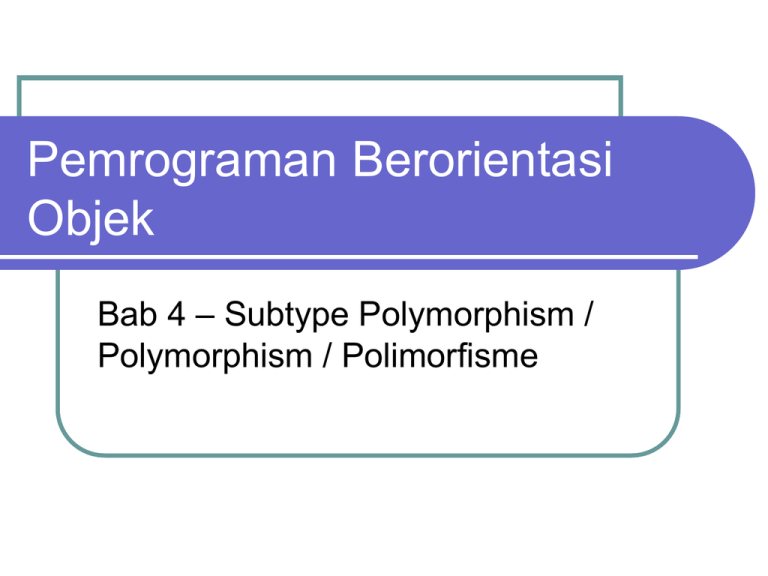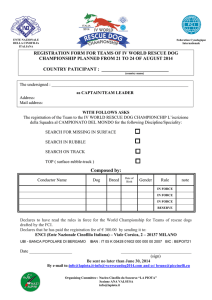Bab 4 - Polymorphism
advertisement

Pemrograman Berorientasi
Objek
Bab 4 – Subtype Polymorphism /
Polymorphism / Polimorfisme
Polymorphism
Is
the ability to create a variable, a
function, or an object that has more
than one form.
The word derives from the Greek
"πολυμορφισμός" meaning "having
multiple forms".
Purpose
The purpose of polymorphism is to implement
a style of programming called messagepassing in the literature, in which objects of
various types define a common interface of
operations for users.
In strongly typed languages, polymorphism
usually means that type A somehow derives
from type B, or type C implements an interface
that represents type B.
In weakly typed languages types are implicitly
polymorphic.
Usage
The primary usage of polymorphism is the
ability of objects belonging to different types to
respond to method, field, or property calls of
the same name, each one according to an
appropriate type-specific behavior.
The programmer (and the program) does not
have to know the exact type of the object in
advance, and so the exact behavior is
determined at run-time (this is called late
binding or dynamic binding)
How?
Inheritance + Overrriding
Sample
public class Animal {}
public class Cat extends Animal {}
public class Dog extends Animal {}
Animal catty = new Cat(); // valid, Cat is Animal
Animal doggy = new Dog(); // valid, Cat is Animal
Cat pussy = new Animal(); // invalid, Animal not only
Cat
Polymorphism Thingy
Virtual Method Invocation (VMI)
Polymorphic Arguments
Operator instanceof
Object Casting
Homogeneous & Heterogeneous
Collection
Virtual Method Invocation
Virtual method invocation merupakan suatu hal
yang sangat penting dalam konsep
polimorfisme.
Syarat terjadinya VMI adalah sebelumnya sudah
terjadi polymorphism.
Pada saat obyek yang sudah dibuat tersebut
memanggil overridden method pada parent
class, kompiler Java akan melakukan invocation
(pemanggilan) terhadap overriding method pada
subclass, dimana yang seharusnya dipanggil
adalah overridden.
VMI Sample
public class Animal {
private String name;
public Animal(String name) { this.setName(name); }
public String talk() {
return “Animals can't talk (except in cartoons)";
}
public void setName(String name) { this.name = name; }
public String getName() { return name; }
}
public class Cat extends Animal {
public Cat(String name) { super(name); }
public String talk() { return "Meow!"; }
}
public class Dog extends Animal {
public Dog(String name) { super(name); }
public String talk() { return "Woof! Woof!"; }
}
VMI Sample
Animal catty = new Cat(“Puss Puss”);
S.O.P(catty.talk());
Animal doggy = new Dog(“Guk Gux”);
S.O.P(doggy.talk());
What’s Happen?
Yang terjadi pada contoh:
Obyek catty & doggy mempunyai behavior yang
sesuai dengan runtime type bukan compile type.
Ketika compile time e adalah Animal.
Ketika runtime e adalah Cat and Dog.
Jadi :
catty & doggy mengakses field milik Animal,
tetapi
catty mengakses method milik Cat, doggy
mengakses method milik Dog
Ingat catty & doggy tipe datanya Animal
What’s Happen? (Cont`)
Bagaimana dengan konstruktor yang
dijalankan?
Pada pembentukan
Animal catty = new Cat();
Pertama kali akan menjalankan konstruktor Cat,
ketika ketemu super() maka akan menjalankan
konstruktor Animal (superclass), setelah semua
statement dieksekusi baru kemudian
menjalankan konstruktor Cat (subclass).
Polymorphic Arguments
Polymorphic arguments adalah tipe data suatu argumen pada
suatu method yang bisa menerima suatu nilai yang bertipe
subclass-nya.
Sample:
public class PrintAnimal {
public void print(Animal a) {
S.O.P(a.getName() + " says: " + a.talk());
}
p.s.v main(String[] args) {
Cat catty = new Cat(“Puss Puss”);
Dog doggy = new Dog(“Guk Gux”);
PrintAnimal pa = new PrintAnimal();
pa.print(catty);
pa.print(doggy);
}
}
Why PA?
Mengefisienkan pembuatan program
Misal Animal mempunyai banyak subclass.
Maka kita harus mendefinisikan semua method
yang menangani behavior dari masing-masing
subclass.
Dengan adanya polymorphic arguments kita
cukup mendefinisikan satu method saja yang
bisa digunakan untuk menangani behavior
semua subclass.
No PA
public class PrintAnimal {
public void print(Cat a) {
S.O.P(a.getName() + " says: " + a.talk());
}
public void print(Dog a) {
S.O.P(a.getName() + " says: " + a.talk());
}
}
Operator instanceof
Digunakan untuk mengetahui tipe data asal dari objek
polimorphic
Mengembalikan boolean T/F
<var name> instanceof <class name>
public class PrintAnimal {
public void print(Animal a) {
if (a instanceof Cat) {
S.O.P(“A cat called ” + a.getName() + " says: " +
a.talk());
} else if (a instanceof Dog) {
S.O.P(“A dog called ” + a.getName() + " says: " +
a.talk());
}
}
}
Object Casting
Seringkali pemakaian instanceof diikuti
dengan casting object dari tipe parameter ke
tipe asal.
Tanpa adanya casting objek, maka nilai yang
akan kita pakai setelah proses instanceof
masih bertipe parent class-nya, sehingga jika
ia perlu dipakai maka ia harus di casting dulu
ke tipe subclass-nya.
Method yang merupakan milik subclass juga
tidak bisa diakses tanpa adanya casting.
How?
public void print(Animal a) {
if (a instanceof Cat) {
S.O.P(“A cat called ” + a.getName() + " says: " +
a.talk());
Cat cat = (Cat) a;
// call defined Cat’s method in Cat class
} else if (a instanceof Dog) {
S.O.P(“A dog called ” + a.getName() + " says: " +
a.talk());
Dog dog = (Dog) a;
// call defined Dog’s method in Dog class
}
}
Homogeneous & Heterogeneous
Collection
Dengan munculnya konsep
Polymorphism, muncul pula sebuah
konsep yang disebut Heterogeneous
Collection dan Homogeneous Collection.
Sebuah collection yang sebelumnya
merupakan kumpulan dari objek sejenis,
sekarang “dipisah” berdasarkan
keberagaman tipe data isi kumpulannya.
Homogeneous Collection
Homogeneous collection adalah
kumpulan objek yang memiliki tipe data
yang sama.
Sample:
Cat[] cats = new Cat[5];
cats[0] = new Cat(“missy”);
cats[1] = new Cat(“sissy”);
dst
Heterogeneous Collection
Heterogeneous collection adalah
kumpulan objek yang memiliki tipe data
yang berbeda – beda.
Sample:
Animal[] animals = new Animal[5];
animals[0] = new Cat(“missy”);
animals[1] = new Dog(“doggy”);
dst
